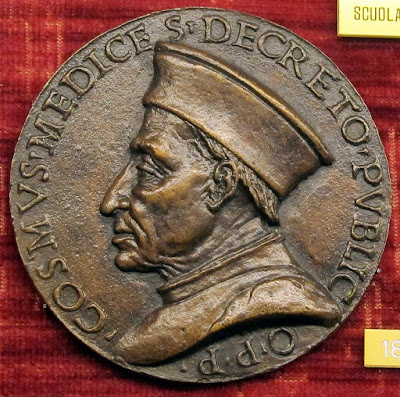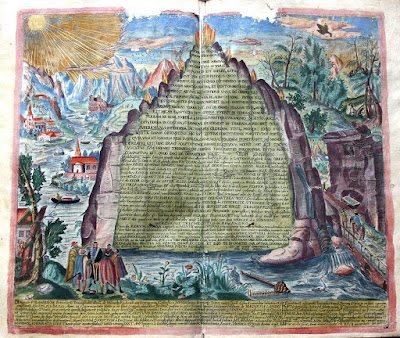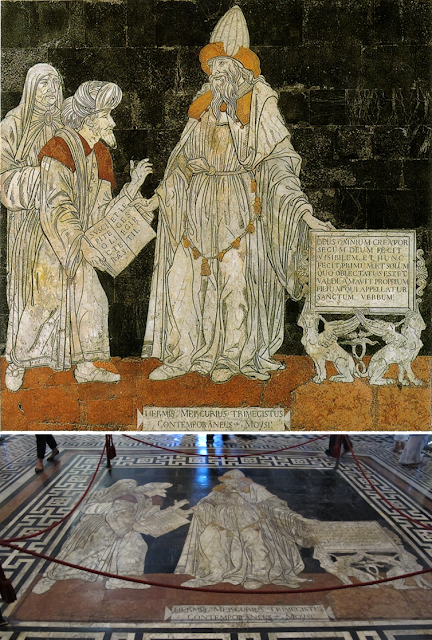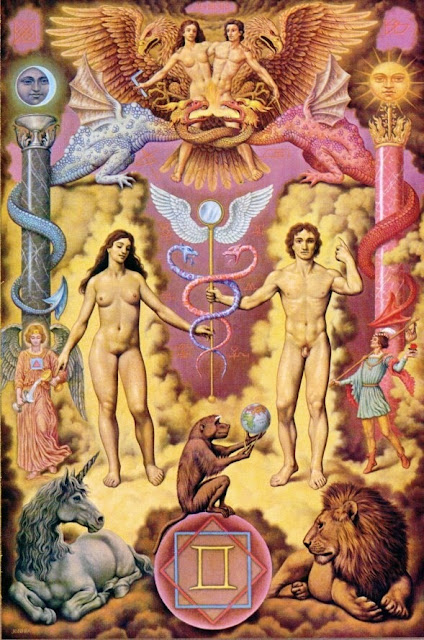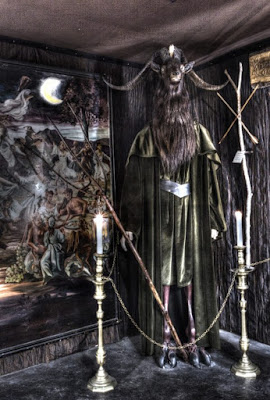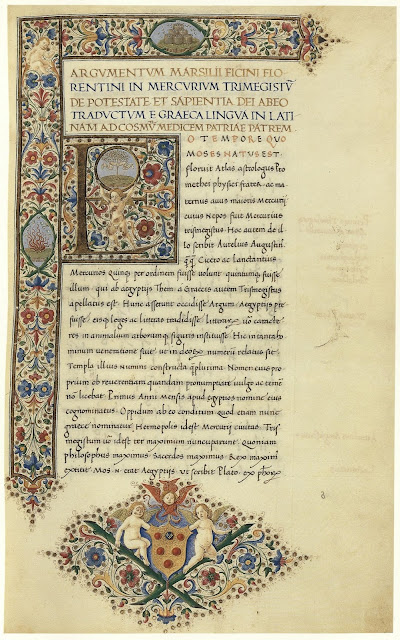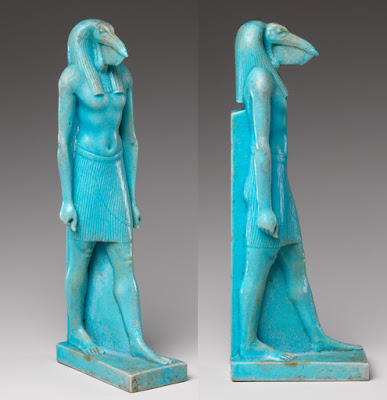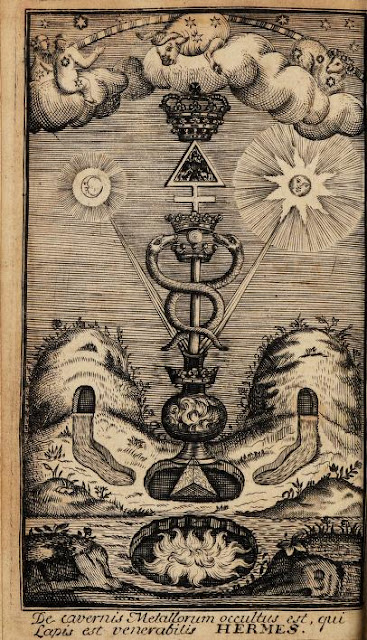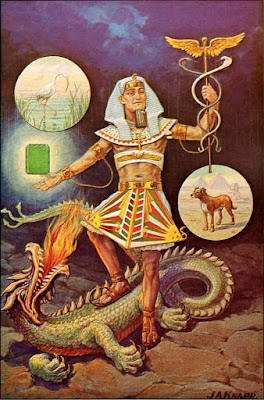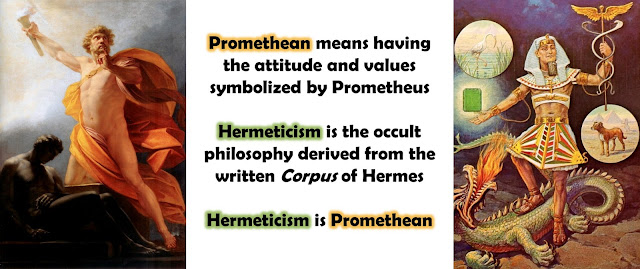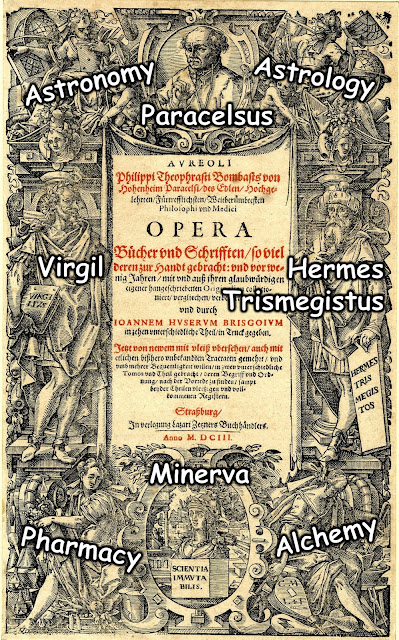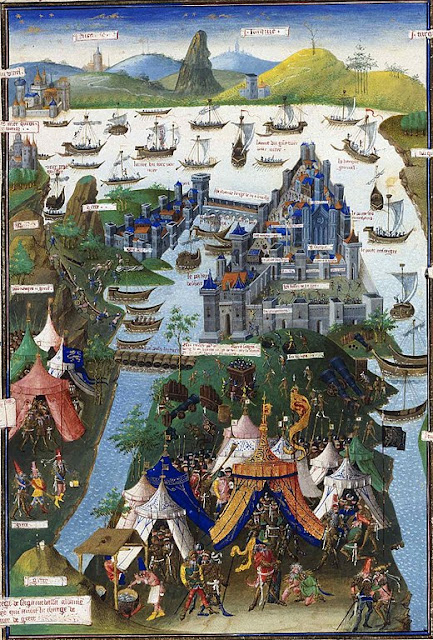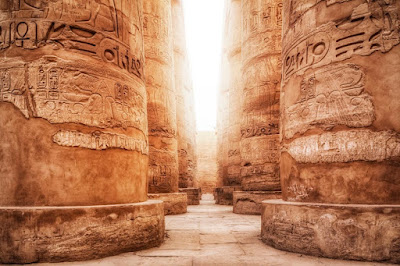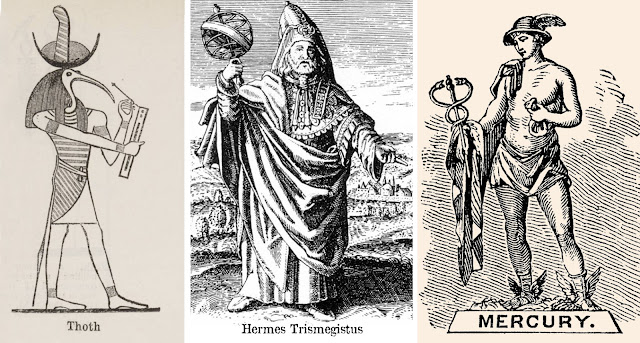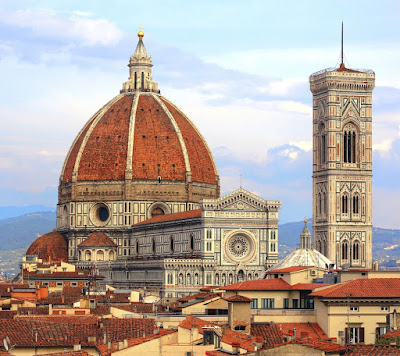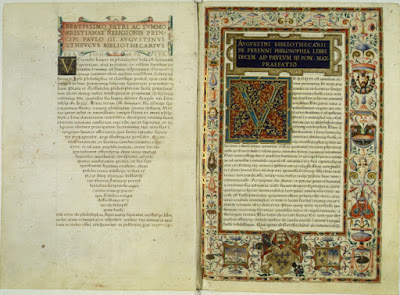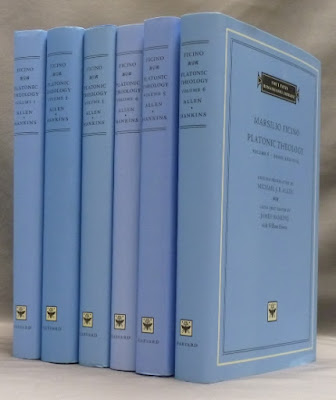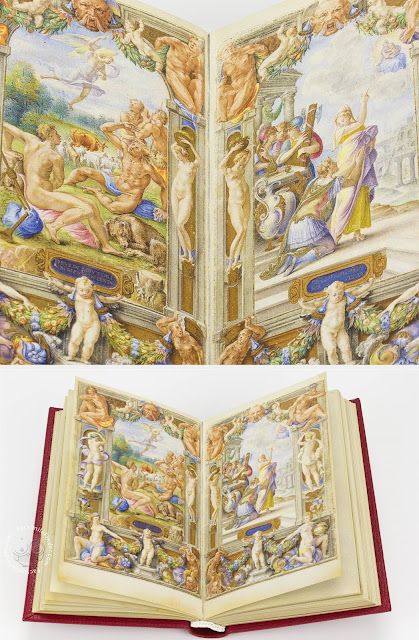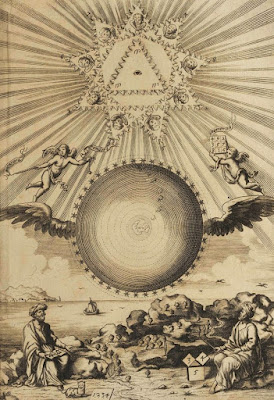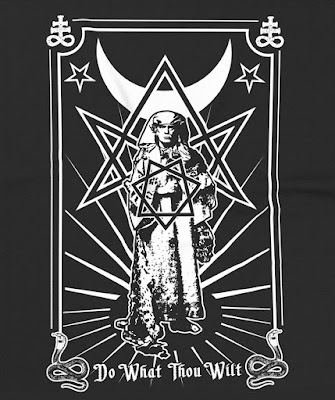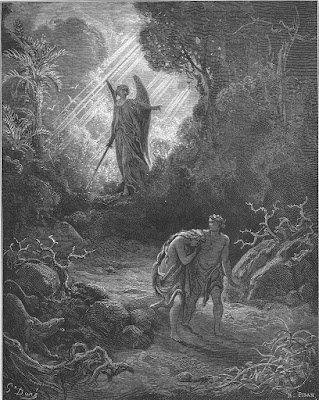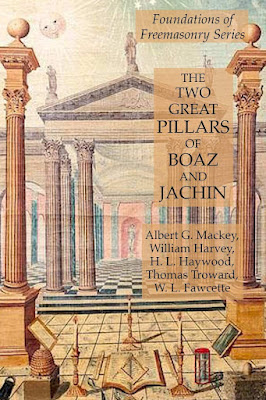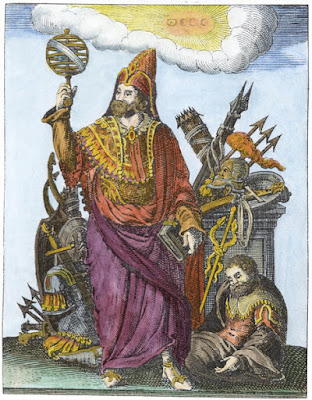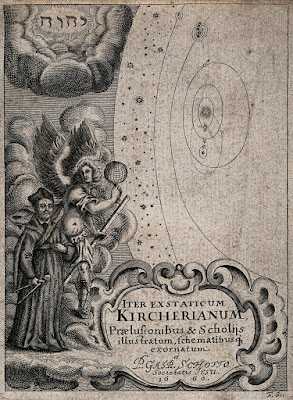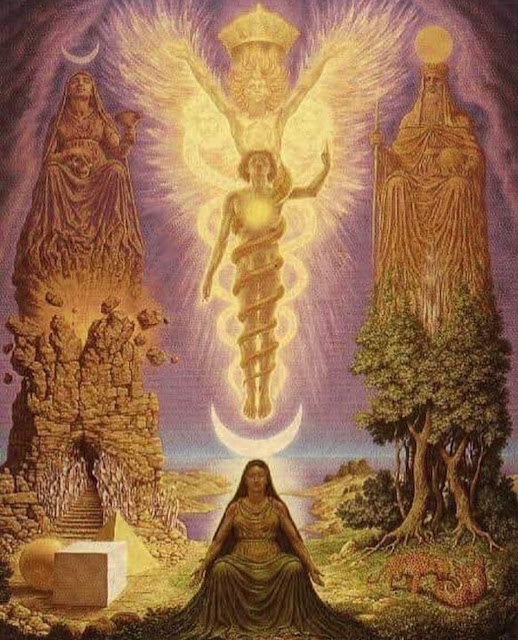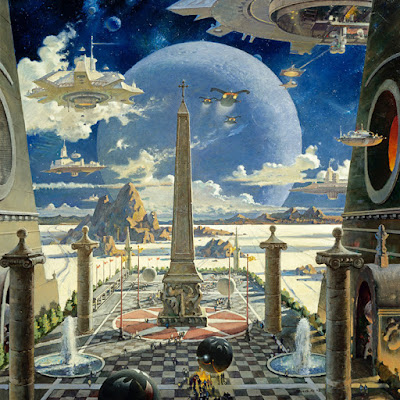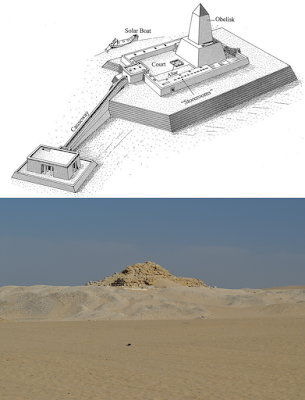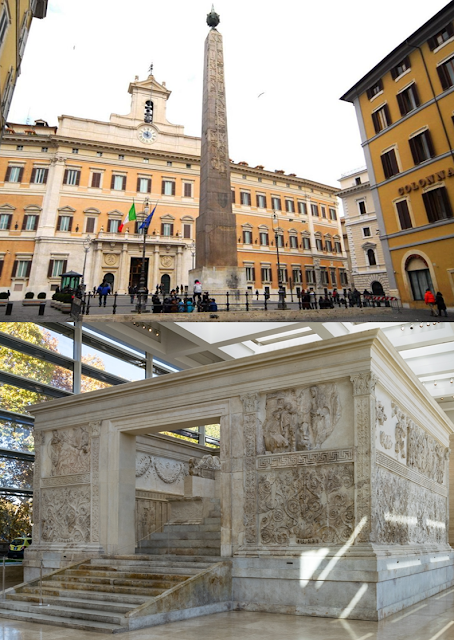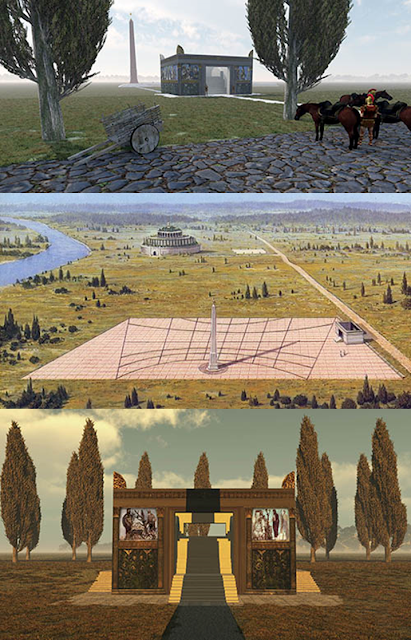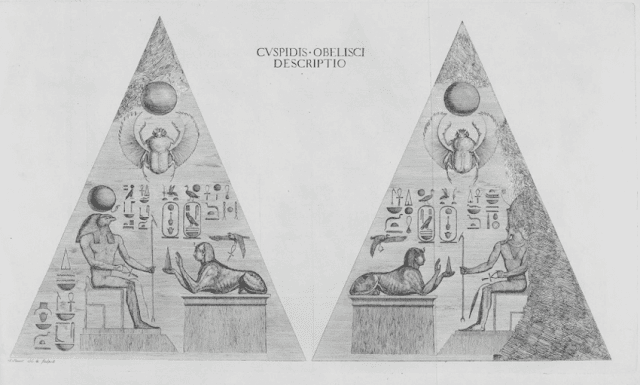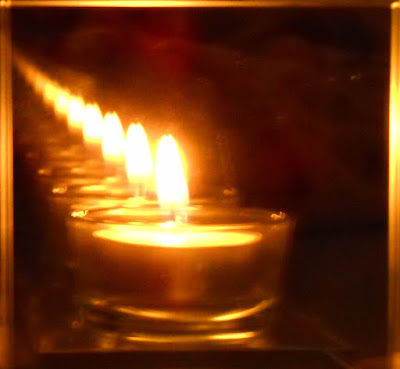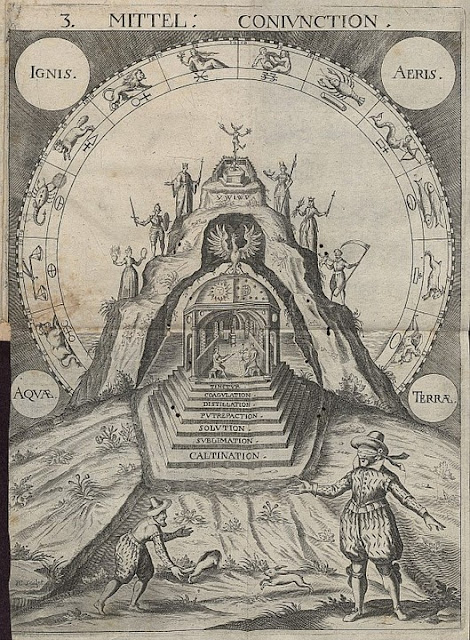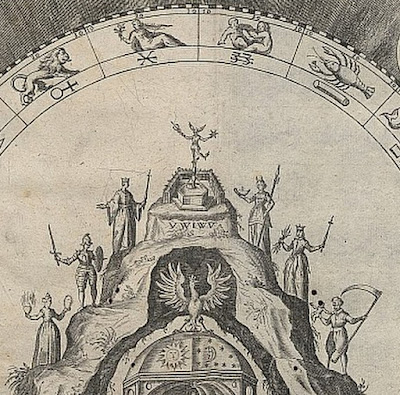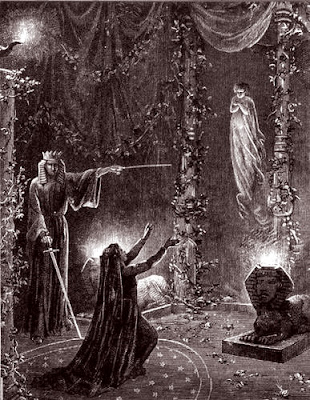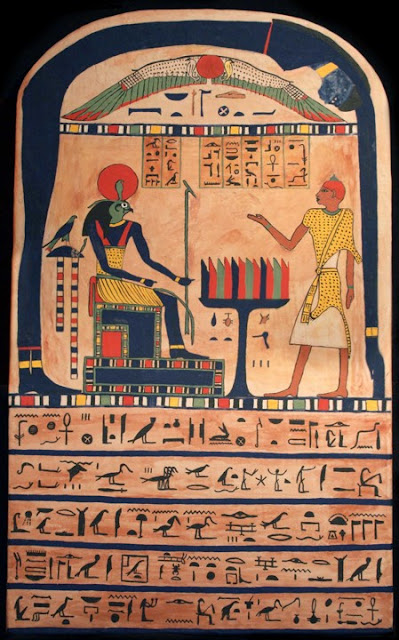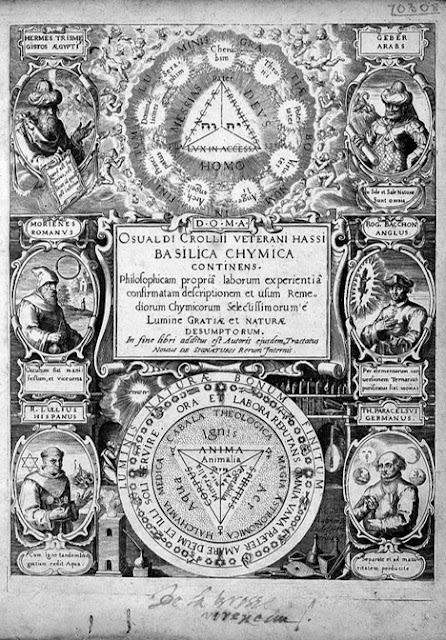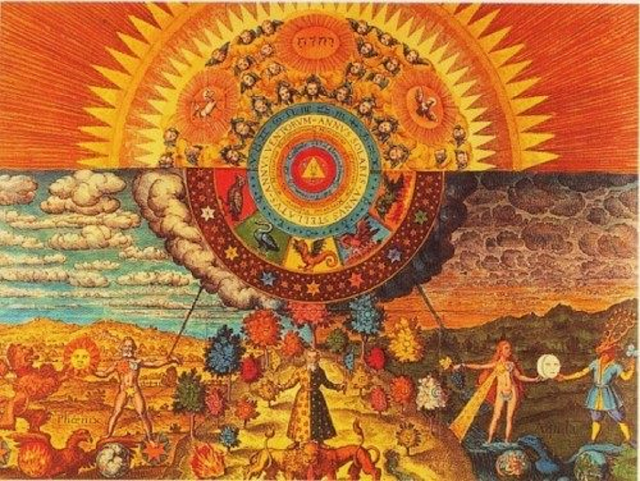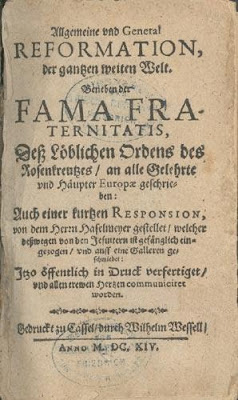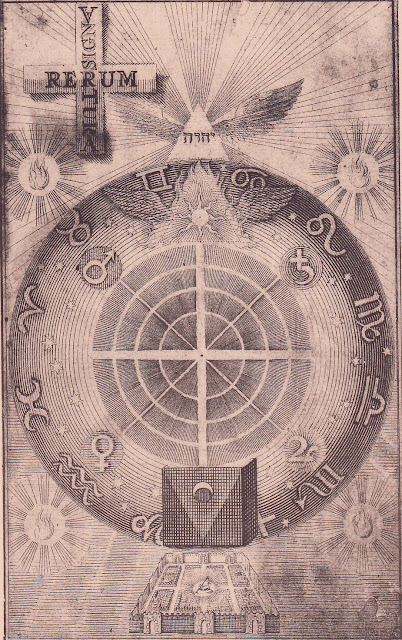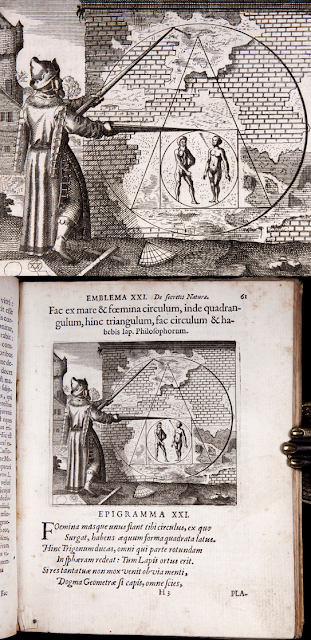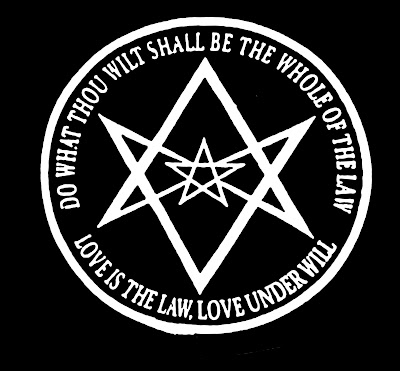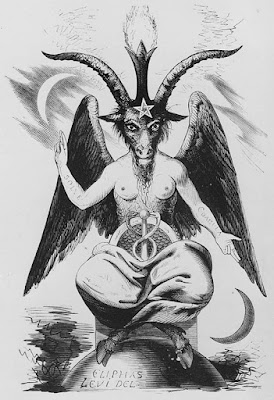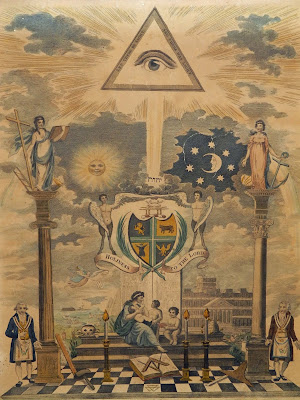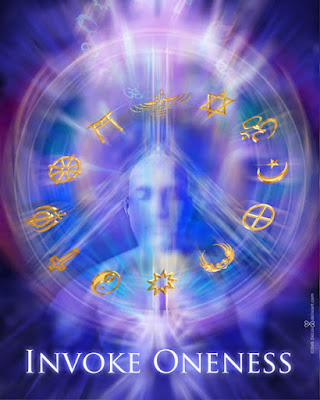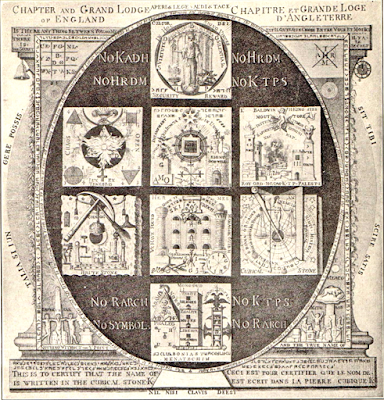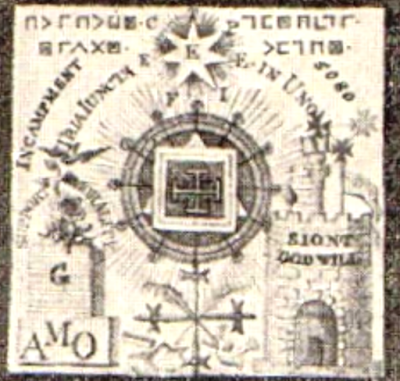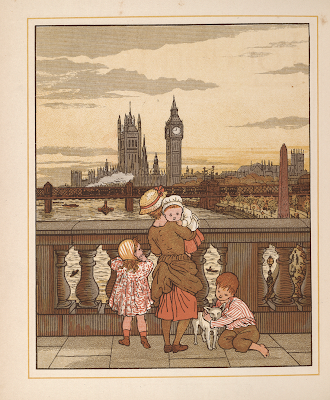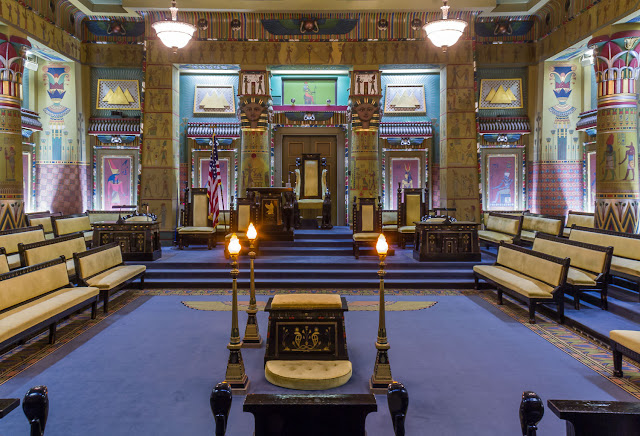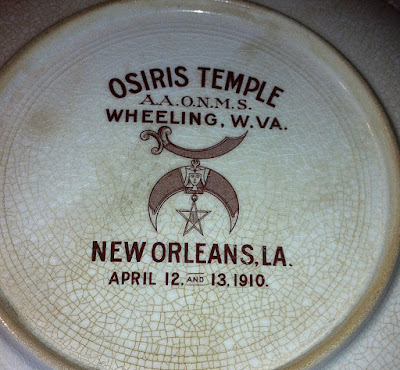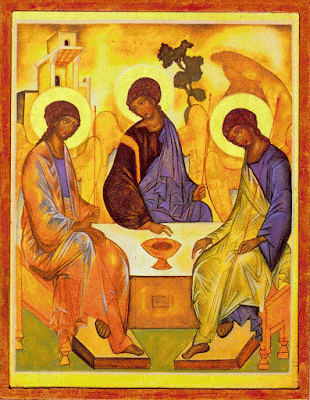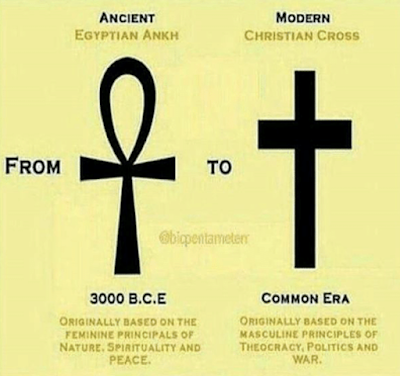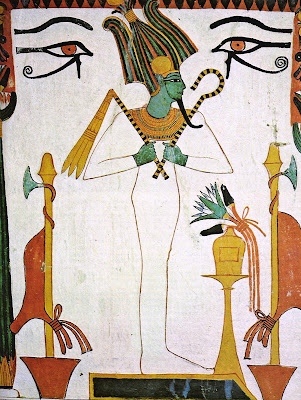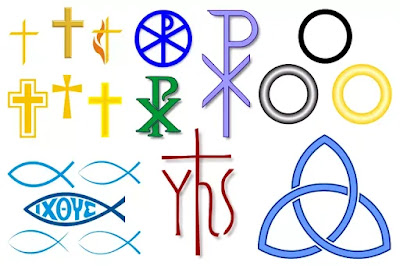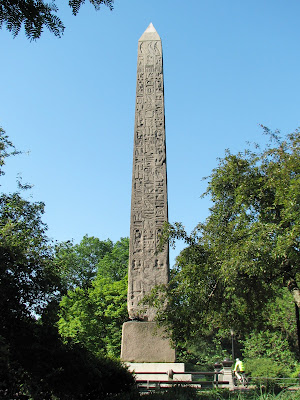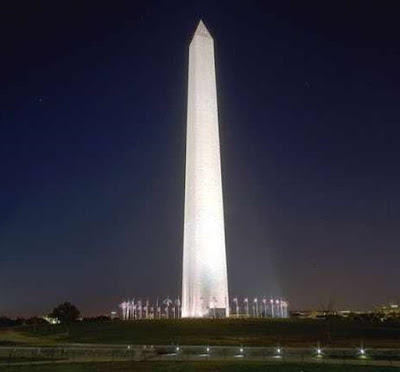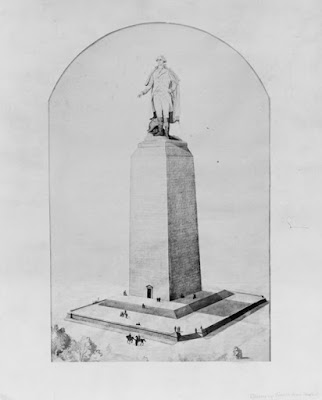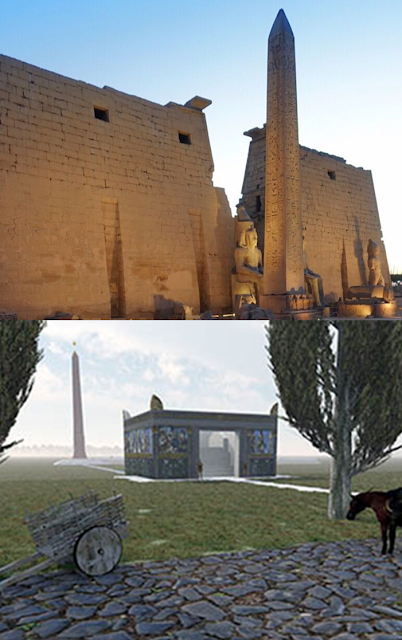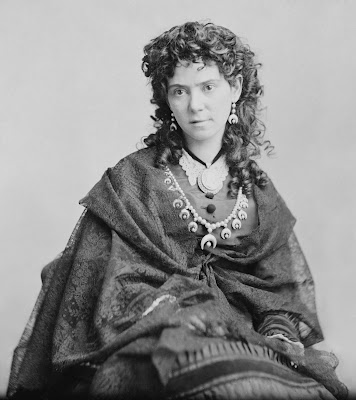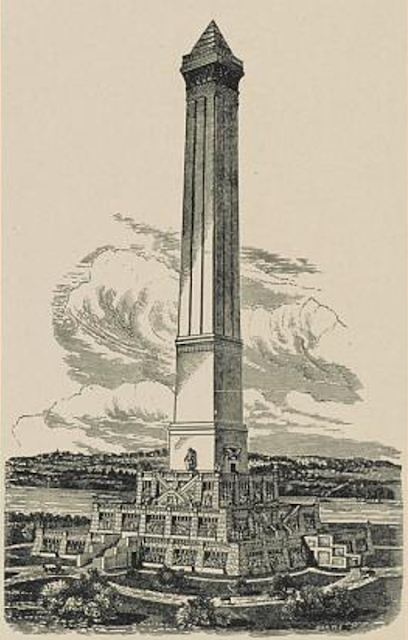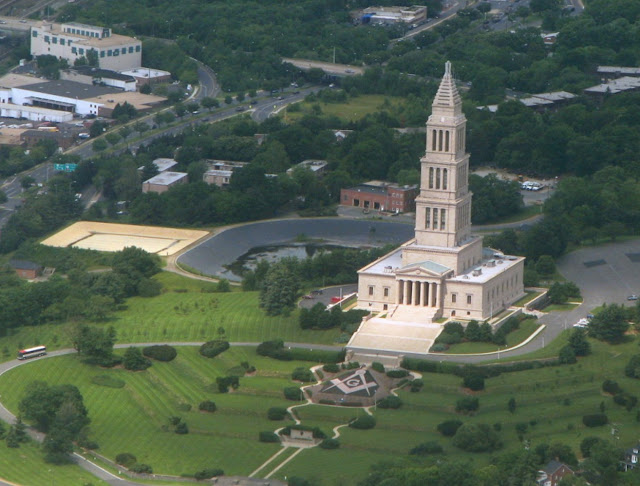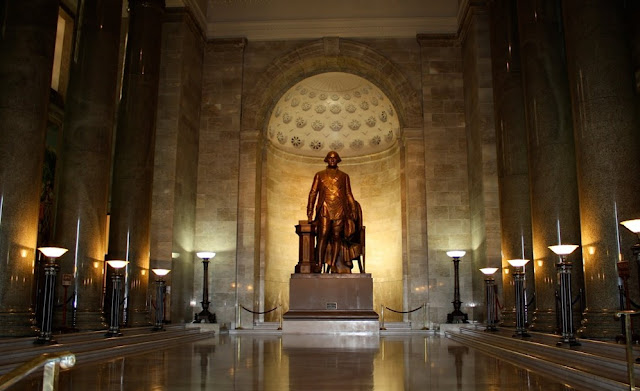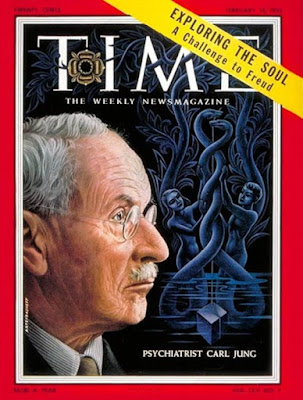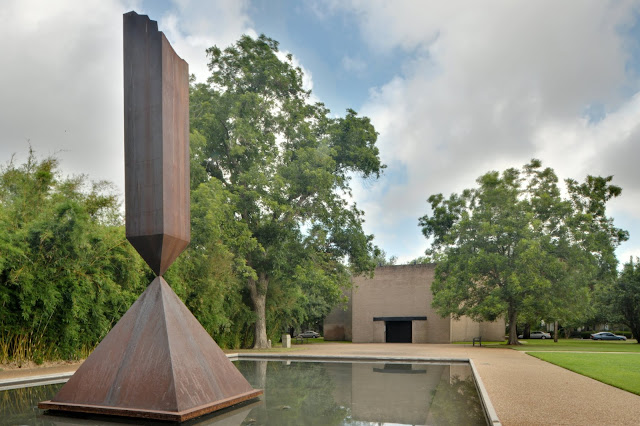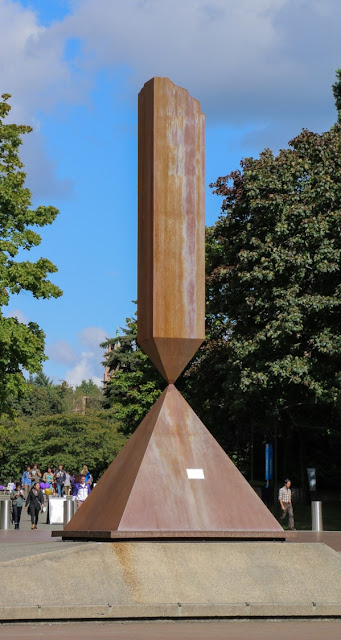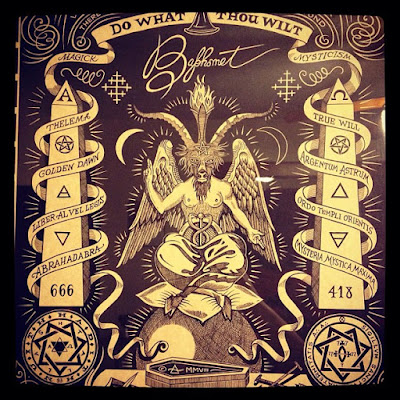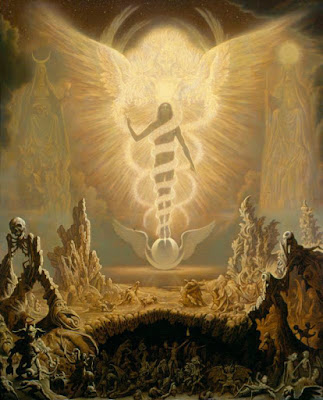 |
| Johfra Bosschart, The Vision of Hermes Trismegistus, 1972 |
If you are new to the Band, this post is an introduction and overview of the point of this blog that needs updating. Occult posts like this one - posts on the history and meaning of occult images - have their own menu page above. All posts are in the archive on the right.
Comments are welcome, but moderated for obvious reasons. If you don't see it right away, don't worry.
It's been a while since an occult post. Time for a look at a mythical fiction that is a direct predecessor to the deceit and moral inversion of globalism.
In 1463 Marsilio Ficino (1433-1499) translated the Greek Corpus Hermeticum into Latin, launching something of a Renaissance craze for the shadowy ancient figure. It's not that Hermes was forgotten during the Middle Ages - the notion that classical knowledge was "lost" and suddenly restored is self-serving Renaissance myth. But a Latin version of the full Corpus plus the Humanist movement that was in full swing by the 1460s combined to make him one of the most important "thinkers" in Europe.
Top and bottom left: Hermes Trismegistus, De Potestate et Sapientia Dei, translated from Greek by Marsilio Ficino, published in Treviso vy Gerardus de Lisa, 1471
Bottom right: Il Pimandro di Mercurio Trimegisto translated from Ficino's Latin by Tommaso Benci, publishedin Florence by Lorenzo Torrentino, 1549
The first published versions of Hermes in Latin and Italian. Ficino's translation circulated in manuscript form from it's completion in 1463 to publication in 1471. Benci was a humanist and friend of Ficino who did an Italian translation that wasn't published until the following century.
More than 20 editions were published by the 1640s.
To put Hermes' importance into perspective, consider the circumstances around Ficino's document. He made his translation for Cosimo de'Medici of the famous banking family - the man who established Medici dominance of Florence by subverting the republican government in the early 1400s.
Medal of Cosimo the Elder, around 1465-1469, bronze
Cosimo was a champion of Renaissance art and culture - he was a main figure in establishing Florence as the center of that movement. Cosimo's cultural activity included support for humanist scholars - he even revived the Platonic Academy in Florence under the leadership of Ficino.
Commemorative medals made to look like Roman coins and medallions with Renaissance humanists and their aristocratic supporters.
When the Greek manuscript copy of Hermes turned up in 1462, Ficino had been working on a translation of Plato - the first into Latin - under Medici patronage. Hermes was considered so important that Cosimo had Ficino put Plato on hold and translate this one first.
The backbone of the Hermetic tradition is made up of two works. The longer is the Corpus Hermeticum - a collection of texts from late antiquity that were brought together in one volume by the Byzantines and translated by Ficino as De Potestate et Sapientia Dei (The Power and Wisdom of God). The Asclepius or Perfect Sermon had been translated into Latin in late antiquity and was was known through the Middle Ages.
Occultic leather binding and title page to The divine Pymander of Hermes Mercurius Trismegistus, translated by John Everard from Ficino's Latin translation, 1650
If you've looked into Hermeticism, you've probably seen the name Pymander or Poemandres or some variation on these. This was the name of the first English translation of Ficino's Latin Corpus but is technically the title of the first tract in the Corpus.
Tabula Smaragdina (The Emerald Tablet of Hermes), 1606, colored engraving
If interested in the texts themselves, click for a link to the G.R.S. Mead translation from 1906. It's probably the best at capturing the stilted weirdness of the prose. The site also includes the Hermetic texts found in 1945 in the Nag Hammadi discovery.
The Emerald Tablet was supposedly written by Hermes, but the oldest evidence comes from medieval Arab manuscripts.
The Hermetic works were written in the late antiquity and belong to the same context that gave us Gnosticism and Neoplatonism. The Gnostic Gnonsense site with the text link next to the picture up above calls the Hermetic tradition a non-Christian lineage of Hellenistic Gnosticism. This is a fair assessment, but Renaissance people like Cosimo and Ficino believed Hermes was way older - a sage of greatest antiquity. They associated him with the Egyptian god of knowledge Thoth and claimed he invented theology among other things. He supposedly even foresaw the coming of Christianity, like the Old Testament prophets. Hermes was a centerpiece of Renaissance prisca theologia - a humanist notion of the 'unity of all religions' idiocy that we looked at in one of the Prometheus posts.
Hermes Trismegistus, 1480's, floor inlay in Siena Cathedral, Italy
That's why this inlaid image of Hermes is in Siena Cathedral. The Renaissance humanists were fully invested in the idea that pre-Christian revelation was given to pagan seers as well as Hebrew prophets. Hermes was the beginning of a tradition that was compatible with and foretold the coming of Christianity.
The Renaissance 'unity of all religions' focused on tying together all the ancient "wisdom" into one big Christian prehistory.
Hermetic philosophy was known in the Middle Ages through different sources. The ignorant claims that it wasn't is part of the b.s. Renaissance myth that the medieval period was an ignorant Dark Age. What actually changes with Ficino's translation is that Hermes goes mainstream. Renaissance culture is filled with Hermeticism - religion, literature, art, science, and what we would call the occult.
Today, Hermes Trismegistus is a central pillar of occult and esoteric thought, although in a more diffuse form known as Hermeticism.
Johfra Bosschart, Gemini, 1975, print
The baboon in the center of this picture is a symbol of Thoth, the Egyptian god associated with Hermes Trismegistus. The rest is a collection of occult, esoteric, and religious symbols - Zodiac, Babylonian astrology, alchemy, Adam and Eve, the Tarot, the Kaballist Tree of Life, Freemasonry, the natural world - that repeat the same theme.
Male and female attributes are a fall from original, primordial Oneness. And the point of all this inverted tripe is to restore ourselves to that state. If that sounds familiar, it's because it's the same tiresome satanic inversion. It collapses the spiritual into the material - a saved soul reuniting with God is not something that happens in the created material world. Ans it tries to reverse Creation by denying the distinctions that are necessary to exist and devolving back into formless chaos.
Sculpture of the Wiccan Horned God, Museum of Witchcraft and Magic in Boscastle, Cornwall
Quick note - we've takeb up the occult-esoteric relationship in earlier posts [click for link]. Both basically mean the same thing - secret knowledge. If we have to differentiate based on how they're normally used, the occult seems more linked to magic, especially supernatural entities.
The esoteric tradition in the West includes knowledge of the occult and other supernatural "sciences" - the alchemy-kaballah-astrology-etc. crowd. Consider the three parts of Hermeticism - astrology, alchemy and magic (theurgy). And it's secret - the word hermetic today means closed off or sealed from the world.
Put it bluntly - Hermes Trismegistus is a big deal in the history of Western culture. A lot bigger than is generally realized. We are going to do a few occult posts on Hermeticism - it is big enough and central enough to the Western occult to deserve it. We've already touched on it in a lot of occult posts because it is so important. So might as well address this fraud in one place.
This post will introduce Hermes himself - the poster child for the incoherence and obfuscation that the occult thrives on. Because there really is no "Hermes Trismegistus". Or whoever was the author of the Corpus Hermeticum - the main collection of Hermes' work - is not the ancient figure that the Renaissance thought.
Manuscript copy of Marsilio Ficino’s introduction (argumentum) to his Latin translation of the Corpus Hermeticum dedicated to Lorenzo il Magnifico, Florence, Biblioteca Medicea Laurenziana, Plut. 21.8, f.3r. 1491
Illuminated hand-copied manuscript versions of published books were common among Renaissance humanists. These presentation copies would be given to the patron - in this case Cosimo's son and heir, Lorenzo de'Medici "the Magnificent".
Hermes is a bit like Prometheus, if it had generally been believed that Prometheus was real. This made him more authoritative until quickly fell out of "respectable" circles. The meaning of Hermes and Hermeticism changes depending where and you are.
To make it worse, the published version of Ficino's translation was so filled with errors that it was almost incoherent. Hermes Trismegistus really was the sort of Procrustean chimera that could be applied to almost anything. To understand him, we have to do what we usually do - look over his long history for patterns. And what we find is that Hermes covers the whole symbolic gamut that we saw in our obelisk posts - the life, spray, and churn of symbols.
The Life of Symbols [click for post] describes how symbols can carry ideas through time long after the groups that started them died out. Anyone can read the Corpus, take up the "wisdom", and claim to be Hermetic. The perpetuity of this symbolic life is why occult movements never seem to go away for good.
Striding Thoth, Ptolemaic Period 332–30 BC, faience, Metropolitan Museum of Art
Faience was similar to enameled pottery and was an old Egyptian art. This piece is from the Hellenistic era - worship of Thoth was already millennia old.
The Spray of Symbols [click for post] described how the occult piles up all kinds of different symbols. Bosschart's Gemini from up above is a perfect example. A spray of esoteric symbolism from unconnected traditions all hammering the hermaphroditic oneness message. They can do this because context doesn't matter - all the Western occult movements share the same the gray sludge/no borders/unity of all religions spiritual inversion. They want to break down distinctions - pretending different things are really the same is the foundation of the entire belief system. It's why we find the occult and the Postmodern so similar.
The Hermetical Triumph: or, The Victorious Philosophical Stone..., published in London by P. Hanet, 1723.
Symbols are a huge part of occult and esoteric "wisdom". They are easily read by initiates but are opaque to outsiders. Illustrations like this - Bosschart's art is a more modern version - are supposed to be meditated on. They're like diagrams, with arrangements of symbols communicating a message about the secret true nature of the universe. `
One claim was that Hermes invented Egyptian hieroglyphics as a form of pure symbolic wisdom.
This book is a translation of 17th century European texts on Hermetic alchemy. Alchemy was one of the three main components of Hermeticism.
The Churn of Symbols [click for post] describes how they change with use over time. It's inevitable that really old symbols used over and over to pretend different contexts are all the same will get fuzzy. New associations are added and outdated ones drop away. There's a push-pull between the life and churn of symbols - the continuity claimed by the life is a fig leaf over the real historical changes of the churn.
The name Hermes Trismegistus is part of the churn.
J. Augustus Knapp, Emerald Tablet of Hermes, 1895, print
Thoth was associated with the Greek Hermes in late antiquity - Infogalactic says both were gods of communication, writing, and magic, and both guided the souls of the dead. Hermes Trismegistus is the hybrid of the two repackaged as an ancient sage and Egyptian king who lived before Moses. Trismegistus means "thrice great" - priest, king, and god.
He appears to have been a late a Hellenistic Greek invention, but his followers claimed he was the the inventor of writing who first transmitted divine knowledge to mankind. The Pymander - the first part of the Corpus Hermeticum that Ficino translated - was said to contain divine wisdom. Hermes is central to alchemy and astrology - esoteric knowledge of heaven and earth.
There is a natural comparison between Hermes and Prometheus as primordial mythic figures connecting humanity to divine knowledge. But they differ is in their natures. Prometheus was a pagan supernatural being rejected by Christianity and turned into a symbol. Images like Prometheus bringing fire or chained to the rock symbolize occult ideas like do what thou wilt and be your own god. But he was never considered a philosopher or theologian or thought to have left a written record. Prometheus represents an inverted attitude or orientation, not a detailed program to follow.
Hermes was considered a real human who became mistaken for a god for his age and wisdom. He wasn't a symbolic image like Prometheus - as we just saw, he doesn't even have a set visual appearance. Hermes is less an occult symbol of human enlightenment than its content creator.
It's the same twisting vagueness that keeps rebooting occult symbols for new users. The life, spray, and churn means that they can never really be pinned down and debunked. Hermes and Hermeticism can be taken up and tapped into over and over. Plus Hermetic thought appeals to different types of occultists differently - the Corpus has astrological, alchemical, and magical branches. New versions of Hermes and the Hermetic tradition keep turning up, adding more layers to this symbolic onion.
Paracelsus (1493/1494-1541) - real name Philippus Aureolus Theophrastus Bombastus von Hohenheim - was a Swiss physician, alchemist, philosopher, esoteric prophet and Renaissance polymath. He's best known in mainstream accounts as an innovator in medicine and toxicology, but he's even more important in occult and esoteric circles as an alchemist. Hermes' philosophy was so important to him that his ideas are sometimes called Hermetic medicine with him as a second Hermes.
Title-page to Paracelsus, Opera, published in Strasbourg by Zetzner, 1603.
This title-page shows Paracelsus with personifications of different kinds of knowledge. On the left are sciences based on observation with Virgil - the poet who expresses nature perfectly. On the right are the occult sciences - secret divine wisdom behind the visible world. Hermes is the champion of these. Matters related to heaven and earth are at the top and bottom. The bust of Minerva on the Masonic-looking cube has a common motto that means unchanging or timeless truth. That is, exactly what you won't find here.
What you will find is the spray and churn that make up the life of symbols.
Some accounts - like the introduction to an 1884 edition of the 1650 English translation of the Pymander from Ficino's version - claim there were two Hermes. One who lived before the Flood and recorded the divine wisdom and another after the Flood who received the knowledge and wrote the Corpus. For all his historical importance, Hermes has no single identity. In some ways he's the perfect Postmodern hero - a fiction created entirely from texts referencing other texts.
It seems a good rule of thumb that whenever we see a spray of symbols thrown together, we're dealing with a gray goo, unity of all religions, dyscivic servant of the Father of Lies.
Engraving of Hermes as Mercury or Filius Noster from Baro Urbigerus, Besondere chymische Schrifften, published in Hamburg in 1705.
The Hermes part of Hermes Trismegistus is also Roman Mercury, who in unity-of-all-religions inversions is also the Holy Spirit or the Word. This Swedenborgian blasphemer explains that this lie originated in Greek myth. Hermes is the Divine messenger and therefore god of oratory, logic, and interpretation of mysteries.
Alchemists like Urbigerus used Hermes or Filius Noster as symbols of the “Universal Self" - the mind enlightened through the alchemical knowledge of the transformation of opposites. The caduceus was the Greek sign of a herald or messenger transformed into the Hermetic symbol of divine wisdom. The Holy Spirit - as in the Christian orb and cross symbol.
The spray of symbols.
So we'll start by looking at what Ficino and the Medici thought they were getting, and then we'll look at what they got. After that, some outlines of Hermeticism after Hermes.
First the context. In practice, Renaissance Humanism was centered on ancient texts. The word means "rebirth" in French and most everyone is familiar with the idea that the Renaissance revived ancient knowledge. Philosophically, the movement claimed absolute truth value for the works of man and sent us down the path to de-moralized Modernist materialism. But practically, the rebirth mostly meant gathering, translating, and interpreting ancient texts.
Jean Le Tavernier, The Siege of Constantinople, from after 1455 in Bertrandon de la Broquière's Voyage d'Outre-Mer, Bibliothèque nationale de France, MS fr. 9087, f.152v.
This started with Petrarch's 14th-century revival of ancient Latin letters. But the Fall of Constantinople - one of the truly great historical failures of Christendom - in 1453 brought a flood of exiled Greek scholars and texts that hadn't been available in the West. Ficino's translations of Hermes and Plato were part of this.
In this world, older meant better. Humanism started with the assumption that ancient culture was superior to more recent medieval culture. But "Classical Antiquity" was itself a mess of texts with long histories of their own. So much Roman stuff was built on Greek sources - getting the older Greek originals seemed like purer truth. And many Greek texts referred back to the even older culture of Egypt. Like we saw with the obelisk post, Greco-Roman antiquity saw Egypt was the quasi-legendary origin of culture.
The claim that Plato studied in Egypt is apocryphal - legends of his supposed travels grew well after his death. Unity-of-all-religions morons take it at face value, but if they were capable of critically analyzing texts, they wouldn't be unity-of-all-religions morons. What it does point to is the connection between Egypt and primordial wisdom in Greco-Roman antiquity.
Hermes was supposed to have been the ancient sage at the dawn of Egyptian wisdom. All sorts of implausible claims have been made about the source of the Corpus without much concern for consistency. The consensus seems to be that Hermes seems to have transmitted some sort of true, divinely inspired knowledge from the beginning of history that survived until the present in secret form. This is why he is so appealing to so many occult branches. Anyone who can mix Hermes into their spray of symbols can claim their tripe is divine wisdom from the dawn of time. He's the ultimate secret king - the king so secret that he never existed.
The Renaissance humanists like Ficino took what was already a mess and filtered it through their own ideas about knowledge and history. Remember - older is better, and Hermes was supposedly much older then the Greco-Roman texts that started the Renaissance. The Humanists' take was different from the ancient one. They weren't reviving the old cult of Hermes the god. Their goal was to build universal understanding out of "lost" knowledge from a Christian starting point. That's Christian as in late medieval Christianity - not the early Christian concepts that influenced the late Antique Hermeticism that the humanists were reading.
Florence Cathedral, begun 1296, Brunelleschi's dome completed 1436.
The symbol of early Florentine Renaissance ingeneuity and cultural leadership - Brunelleschi's amazing dome of the Florence Cathedral - was a church.
Right next to the bell tower designed in the preceding century by the father of the Florentine painting tradition Giotto.
By the Renaissance, European Christianity had developed over a thousand years into the dominant belief system. It was universal in scope, with a clear structure and comprehensive dogma. The ancient pagan world was the opposite, with lots of different cults coexisting - competing, merging, splitting. Christianity was exclusive. Renaissance Christian Humanism was looking to modify the existing Christian system by incorporating pagan "wisdom" rather than setting up an impossible alternative.
Agostino Steucho, De perenni philosophia, around 1540, Vatican Library, Vat. lat. 6377 f.17v.-18r
Later humanist compilation of extracts from Greek philosophers, Chaldean sages, and the sibyls that teach the importance of religious devotion by a humanist Vatican librarian. Steucho presented these "flowers picked from all of philosophy that give off the scent of divinity" to Pope Paul III directly.
This is what makes the humanists forerunners of globalism. They claim to want to "improve" or "modernize" Western culture, when what they are doing is inverting it's basic values. The sibyls and sages come from systems of thought that diametrically contradict Christian metaphysics. The fact that they happen to agree on some point is irrelevant to the logical impossibility of both being true. The Ficinos and their afterbirth - like Steucho - follow a formula.
1. Find an ridiculously simple point of agreement between Christianity and a contradictory concept of reality.
Michael J.B. Allen's translation of Ficino's Platonic Theology, Harvard University Press, 2006
Emphasis on ridiculously simple - Ficino's magnum opus - the "synthesis" of Neoplatonism and Christianity shown here - was based on the immortality of the soul. Steucho's is that piety is a virtue.
We've mentioned prisca theologia before - the humanist prototype of the Unity-of-all-Religions. It means primordial theology - all belief systems are different refractions of the same original Truth. Prisca theologia is this step applied to a bunch of different contradictories.
2. Claim that the contradictory concept of reality therefore has an element of Truth because it "predicted" Christianity. This bestows the status of Old Testament prophecy on anyone who said anything that resembles any bit of Christianity.
Facsimile edition of Giulio Clovio's Farnese Hours, 1537-46 for Alessandro Farnese (1520–1589), Pope Paul III's nephew
One of the most impressive Renaissance manuscripts. It was made for the nephew of the same pope that Steucho made his Perennial Philosophy for. On the right is the legend that the Tibertine Sibyl predicted the coming of Jesus to Augustus. She's pointing to a vision of the Madonna and Child. On the left, the angel announces the birth of Jesus to the shepherds. The implication is that Biblical and sibylline prophecy are comparable.
The argument for prisca theologia goes like this: Humanists found some things in common in a bunch of ancient texts...
...
...
That's it. 3. If you accept contradictory concepts as also True, you have to change basic Christian metaphysics to accommodate the contradictions.
Gustave Doré, The Triumph Of Christianity Over Paganism,1868, oil on canvas. 118 x 79 in, Art Gallery of Hamilton, Ontario
This isn't a problem when Christians reject beliefs that contradict the fundamental pillars of their faith. But once you include them, those pillars that disagree with them have to go.
Humanists blathered on about Hermes claiming one God and brush aside the metaphysics of salvation. Sometimes salvation is treated like a metaphor for a new "golden age"
4. This is the Gnostic switch - replace grace with "knowledge".
Title page to Athanasius Kircher's Arithmologia, published in Rome by Varesij, 1665
Like the Jesuit polymath connecting non-Christian forms of number mysticism to an image of the Trinitarian Christian God. You'll notice the lack of Jesus or even a Christ-symbol in this "Christian's" occultism.
The Old Testament becomes incomplete if there are other revelations to be added elsewhere. This shatters the integrity of the Bible, just drops the whole concept of the Fall and God's covenants, and turns truth into something you have to sniff out and piece together. That's the esoteric approach of alchemy and Gnosticism - erasing distinctions to return to a primal unity. The gray entropic goo of anti-Creation.
5. It anticipates the do what thou wilt unity-of-all-religions gray goo peddled by globalism and its satanic collectivist fellow travelers.
The Aleister Crowley throw blanket.
Putting the search for "truth" in your hands means you ultimately decide which of the spray of symbols you think is correct. You literally make your own truth.
Note the Egyptian headdress.
From Christian humanism to luciferian postmodernism in a few easy slips. Once you pretend that the different is the same, you've entered into a world of lies. And once that threshold is crossed, there is no standard to make moral judgments against. At this point it's do what thou wilt, with whoever controls the money and apparatuses of power calls the shots.
Looking past the spray, we can see that Hermeticism in the Renaissance combined Christianized prisca theologia with the older is better school of knowledge.
Christianity also had an primordial "Golden Age" in the Garden of Eden that humanists churned into their belief that ancient learning is purer and closer to truth. In a recent regular Band post we mentioned how prelapsarian - before the Fall - Adam showed his true knowledge of Creation when he named the animals. After the Fall, reality gets less clear and language turns arbitrary and subjective. If we could just stop here, you can see how clever interpreters could fit this "lost wisdom" account to an older-is-better approach to knowledge.
Gustave Doré, Adam and Eve Are Driven out of Eden, from Doré's English Bible, 1866
Pretend this is like a pagan golden age that they're forgetting.
There's an ancient legend that Adam retained some awareness of this pure truth. Josephus (37-c. 100 AD) wrote that this passed to his grandchildren through his son Seth, who inscribed it on two columns for posterity. This is where Hermes' extreme antiquity comes in. According to some, Hermes is the one who transcribed the wisdom of the columns after the Flood in a hieroglyphic language that he invented. Some claim he passed this on to Abraham. Others churn in another Hermes as the person who supposedly made the columns before the Flood - this one is also Thoth.
Whatever the details of the spray, the outline of Renaissance Hermes is a central figure in the prisca theologia.
This one lingers on in Freemasonry. Consider H. L. Haywood's 2020 The Two Great Pillars of Boaz and Jachin published by something called the Lamp of Trismegistus. The Mason's Boaz and Jachin are the two columns of Hermes with the Adamic knowledge. The idea here is that the Freemasons are the one who have it.
They can even twist the Bible and make it occult. Adam's "secret knowledge" that isn't contained in Scripture? Cool story, but the complete inversion of Christian revelation.
It's the life, spray, and churn of symbols.
The problem for humanists and occultists is that it doesn't just stop here. It's important to identify how this prisca theologia deception inverts the Christianity it claims to enrich.
Prelapsarian Eden was a place of true knowing, but the rupture created by the Fall goes way beyond losing some knowledge. It's an existential change - a change in our nature and in the nature of the world around us.
Thomas Cole, Expulsion: Moon and Firelight, circa 1828, oil on canvas, Thyssen-Bornemisza Museum
The only way to cross over this divide is salvation through faith in Jesus' sacrifice, and even that faith doesn't bring the clarity of the unfallen. This is what makes Christianity diametrically opposite Hermeticism, Gnosticism, Luciferianism, alchemy, and all the other occult inversions. It recognizes that as limited, subjective beings, our grasp of the universe around is finite. The occult is the complete opposite. It pretends that we can somehow reach timeless absolute truths through manipulating arbitrary man-made symbols.
This gives Renaissance Christian humanism and Hermetic Christianity a bit of a problem. They aren't Christian. They'r the first stage of satanic inversion.
Mercurius Trismegistus, engraving from Pierre Mussard, Historia Deorum fatidicorum, Venice, 1675.
Hermes with a bunch of his symbols. The one he's spinning like the first Globetrotter is an armillary sphere. This is symbol of his astrological knowledge of heavenly things - see the opening through the clouds to the divine name and golden light.
Gaspar Schott, Athanasius Kircher being guided by an archangel to the celestial spheres, engraving by F., 1660, Wellcome Library
And Jesuit "Christian" Athanasius Kircher with a bunch of esoteric symbols - including old friends the compasses. The armillary sphere is held by an angel, certifying the validity of the knowledge of the heavens. Here too, the astrological knowledge opens a cloudy window to the divine. The Hebrew lettering indicates that this is specifically the God of the Old Testament. The Christian God.
Note the lack of Jesus in the Hermetic Christian vision. The pathway between man and God isn't the Incarnation and Resurrection, it's esoteric knowledge. The same esoteric knowledge that can be found in a fictional pagan occult archetype. Hermeticism is like Gnosticism because it based on overcoming a "Fall" that is described in terms of forgetting. It's the symbolic erasure of logical and natural distinctions that can return humanity to a state of perfection. This utterly contradicts the entire metaphysics of Christian Fall and salvation, and easily eliminates the need for Jesus at all.
Hermes, engraving from J. A. Siebmacher, Das güldene Vleiss, published in Nurnberg, 1737
Real treasure and paper wealth are among the opposites balanced here. The arrangement of the symbols is familiar now - Hermetic enlightenment through balancing opposites.
So that's what the Renaissance humanists thought they were getting. An originator of the Egyptian mystical and beloved Greco-Roman traditions with matchless older-is-better cred - including ties to Christian pre-history. That's a pretty terrible thing to rearrange your faith around, but they really do seem to have believed they had stumbled onto philosophy from the dawn of history.
The reality was that "Hermes Trismegistus" was a late Antique fraud - the Corpus dates to around the 3rd century AD. The next post will look at what Hermes really is, and why Hermeticism is such an occult plague on the culture of the West.

